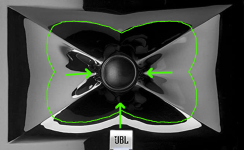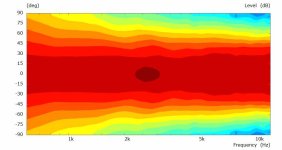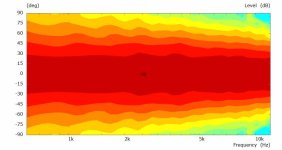Can anyone tell me how the image control waveguide improves on a standard rectangular waveguide?
Forgive me if this has been discussed elsewhere. I did see a 2018 patent which describes this feature as "clover like," but did not understand the patent. I do understand that the function of the waveguide is primarily to reduce dispersion at low frequencies to better match the directivity of the HF driver to the LF driver.
Forgive me if this has been discussed elsewhere. I did see a 2018 patent which describes this feature as "clover like," but did not understand the patent. I do understand that the function of the waveguide is primarily to reduce dispersion at low frequencies to better match the directivity of the HF driver to the LF driver.
Attachments
There is a lot of info on the JBL waveguides around here. Pictures might explain better then words. so the threads linked are worth a look.
They trade off directivity and smoothness in the orthogonal axis, for vertical and horizontal performance. Few measure that way so a good mind trick. This one looks to have the same 'knuckles'(diffraction slots) as the M2 waveguide, so see those discussions.
https://www.diyaudio.com/community/threads/unitized-image-control-waveguide.319698/
https://www.diyaudio.com/community/threads/jbl-m2-for-the-poors.247050/
https://www.audioheritage.org/vbulletin/showthread.php?33972-JBL-Master-Reference-Monitor
They trade off directivity and smoothness in the orthogonal axis, for vertical and horizontal performance. Few measure that way so a good mind trick. This one looks to have the same 'knuckles'(diffraction slots) as the M2 waveguide, so see those discussions.
https://www.diyaudio.com/community/threads/unitized-image-control-waveguide.319698/
https://www.diyaudio.com/community/threads/jbl-m2-for-the-poors.247050/
https://www.audioheritage.org/vbulletin/showthread.php?33972-JBL-Master-Reference-Monitor
"They trade off directivity and smoothness in the orthogonal axis, for vertical and horizontal performance"
When you say orthogonal, I'm assuming you mean diagonal? That is, if a speaker was rotated 45 degrees about the on-axis measurement line, and then spins were taken?
Would be nice to see a demonstration of FR/directivity with and without, but I'm guessing that is not out there.
Another Q: On the compression driver speakers this shape is very pronounced, but on the cheap dome tweeter monitors it is more subtle. Is this more for show on the cheap monitors? I.e. to give them a family resemblance to the higher end stuff?
When you say orthogonal, I'm assuming you mean diagonal? That is, if a speaker was rotated 45 degrees about the on-axis measurement line, and then spins were taken?
Would be nice to see a demonstration of FR/directivity with and without, but I'm guessing that is not out there.
Another Q: On the compression driver speakers this shape is very pronounced, but on the cheap dome tweeter monitors it is more subtle. Is this more for show on the cheap monitors? I.e. to give them a family resemblance to the higher end stuff?
Seems reasonable since adding to a round horn is only useful for throat bracing and/or compression loading, which we normally don't want to do to a cone/dome driver.
I can't speak for JBL waveguides even though I have one but the shape itself has no inherent need to make that trade off. All the good profiles I have simulated are well behaved in the diagonal. It is much easier to check with a BEM observation script than finding a way to take diagonal polar measurements in real life. You can see the difference between H and D in the attachments."They trade off directivity and smoothness in the orthogonal axis, for vertical and horizontal performance"
It's not really possible to view it as with/without as the entire device is different then, the best single curve to use is unlikely to be the same as one to vary around the axes.Would be nice to see a demonstration of FR/directivity with and without, but I'm guessing that is not out there.
It could be but dome tweeters need quite specific waveguides designed for them and each dome responds very differently based on it's geometry and how high in frequency it remains like a piston.Another Q: On the compression driver speakers this shape is very pronounced, but on the cheap dome tweeter monitors it is more subtle. Is this more for show on the cheap monitors? I.e. to give them a family resemblance to the higher end stuff?



